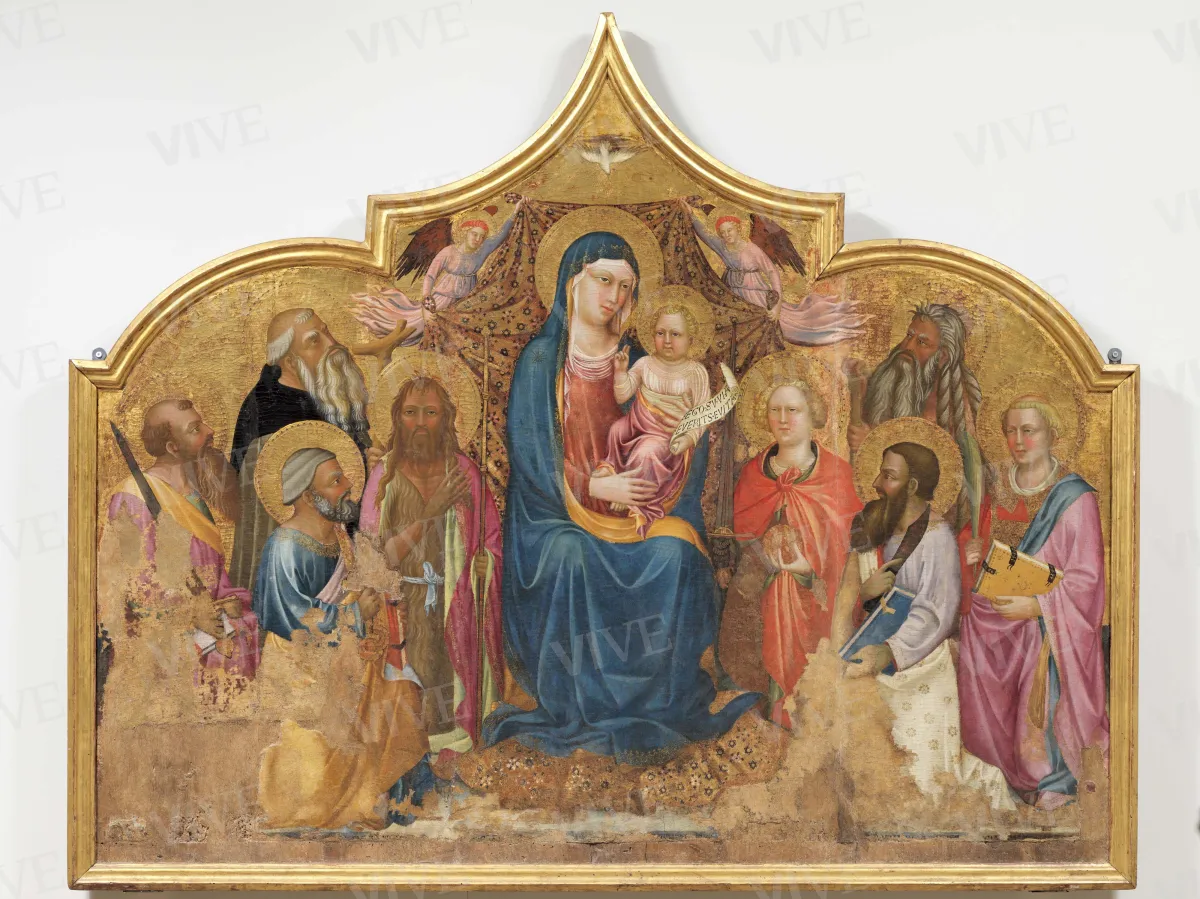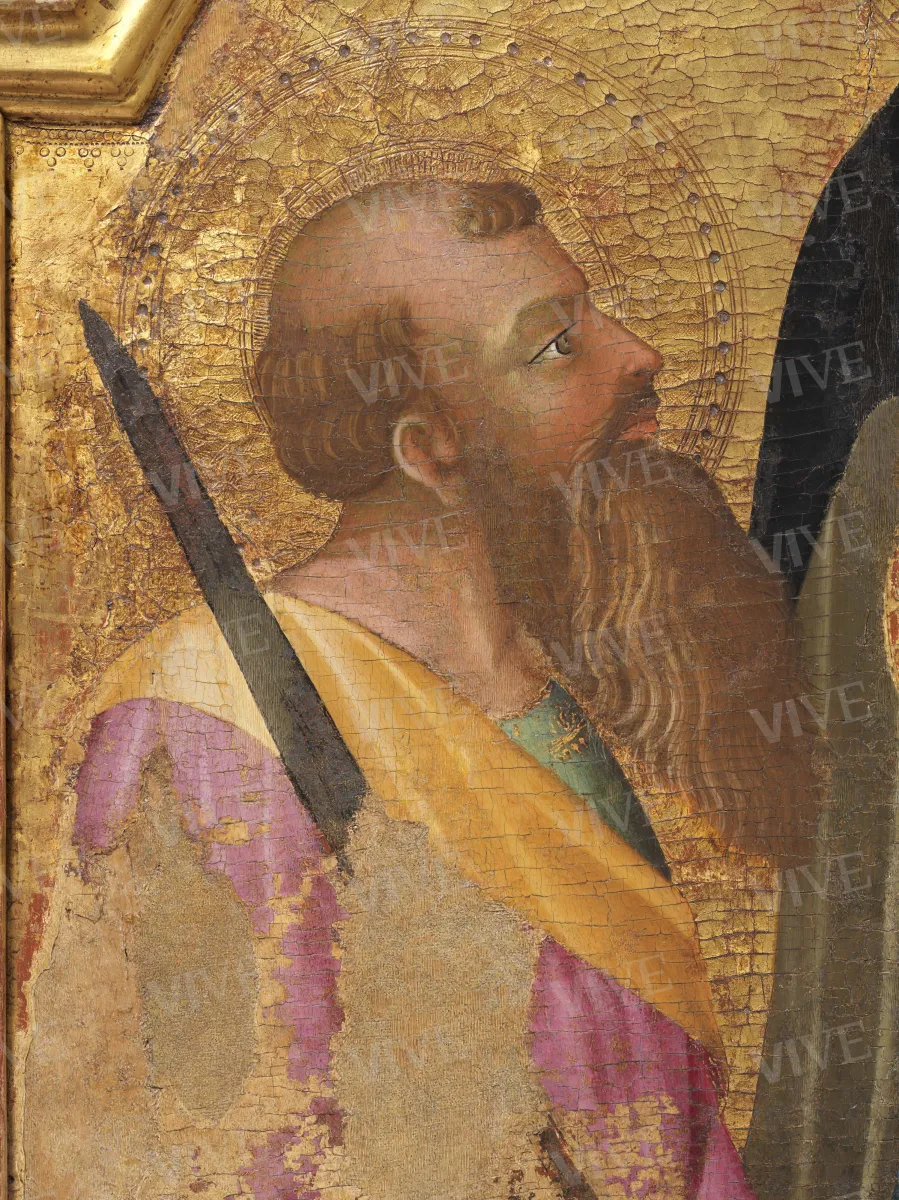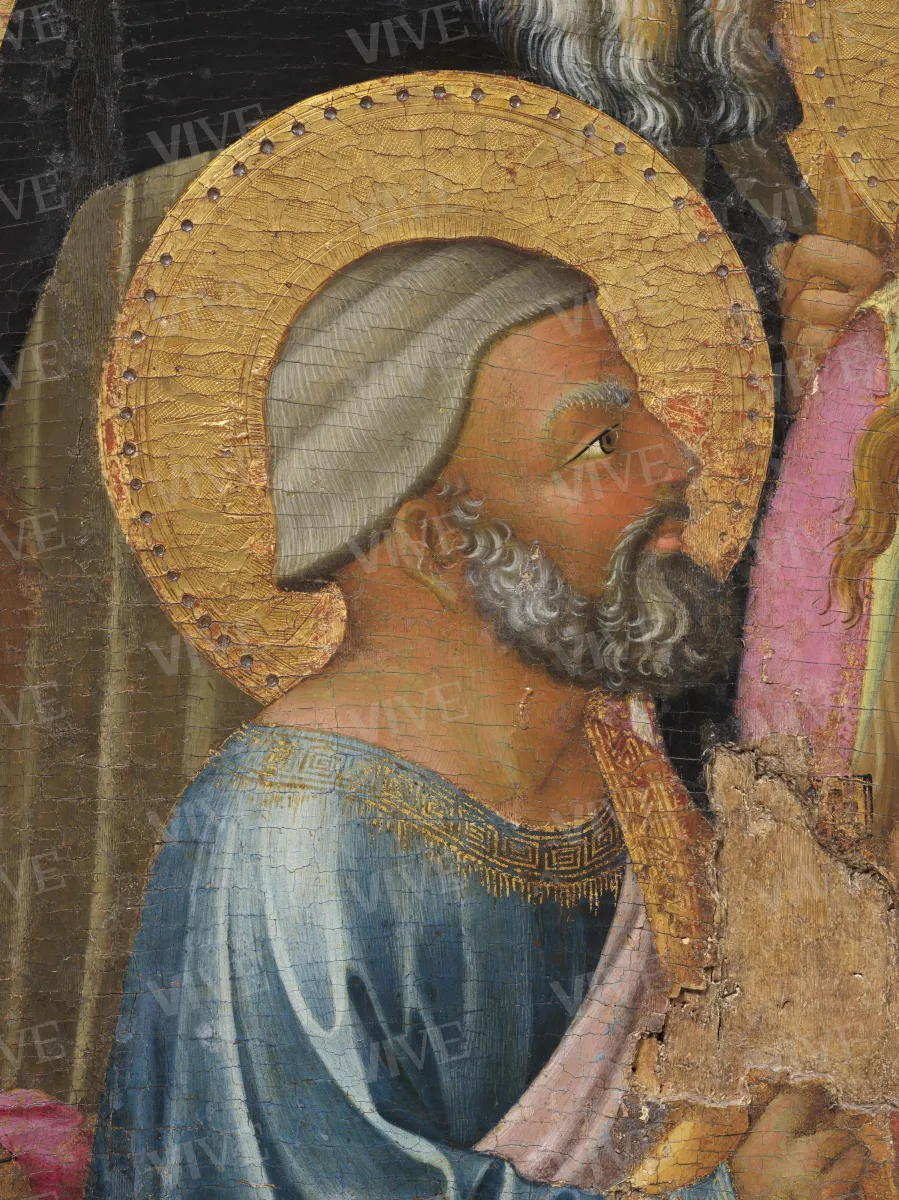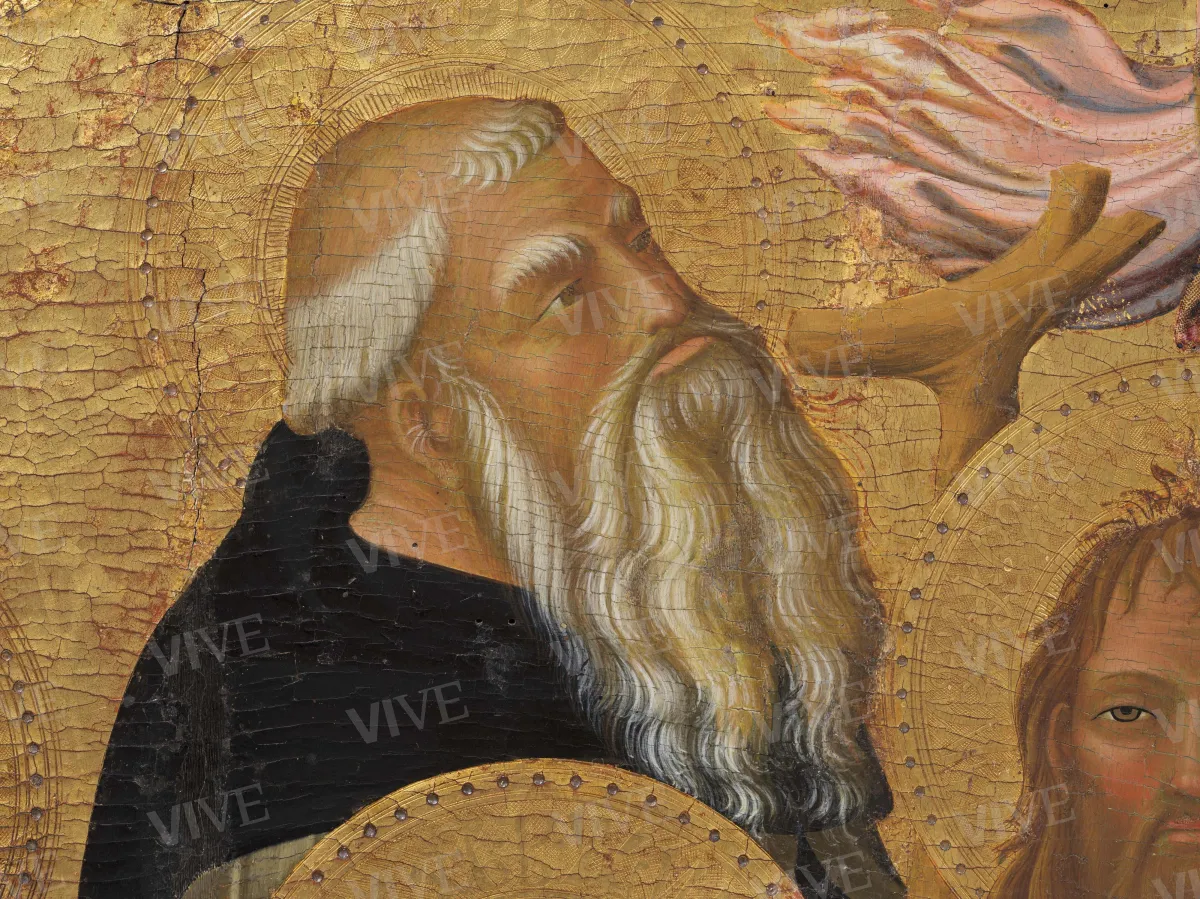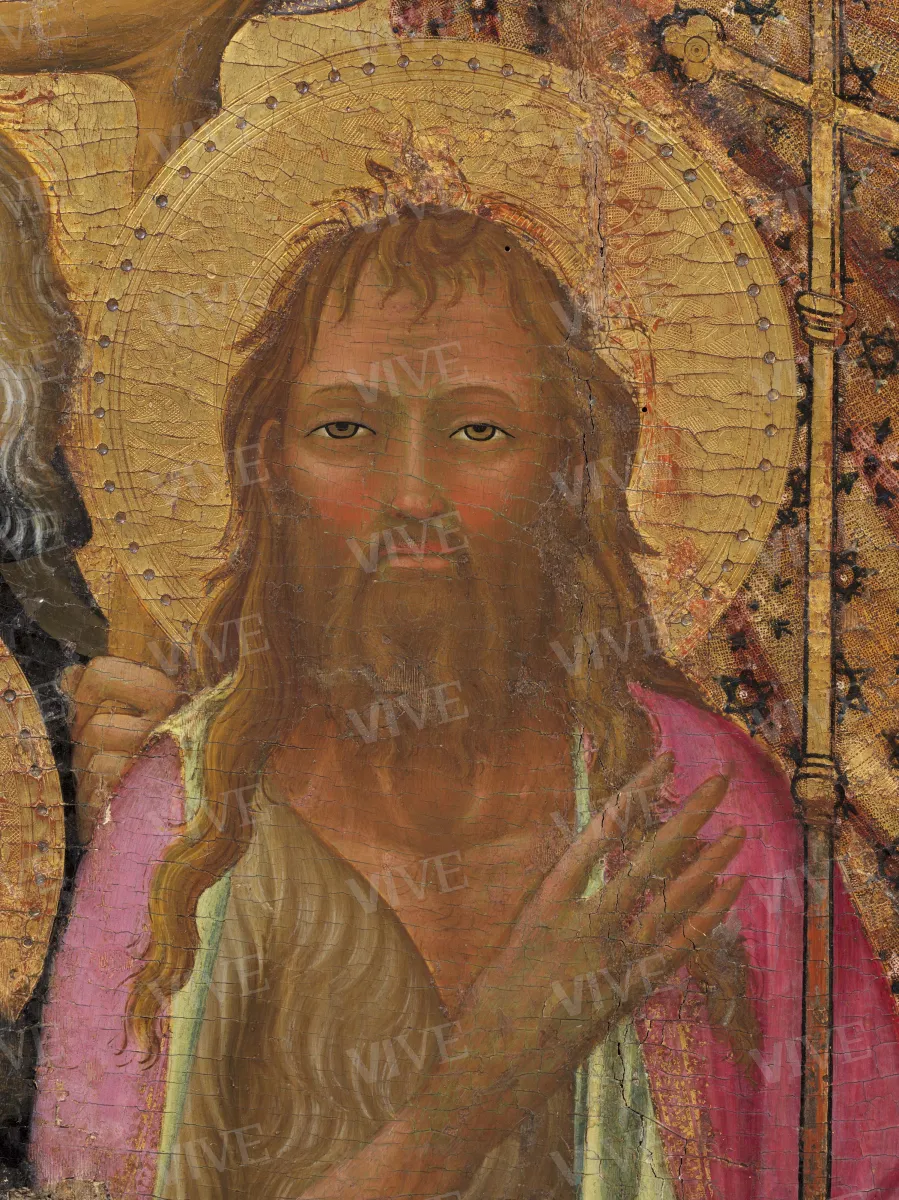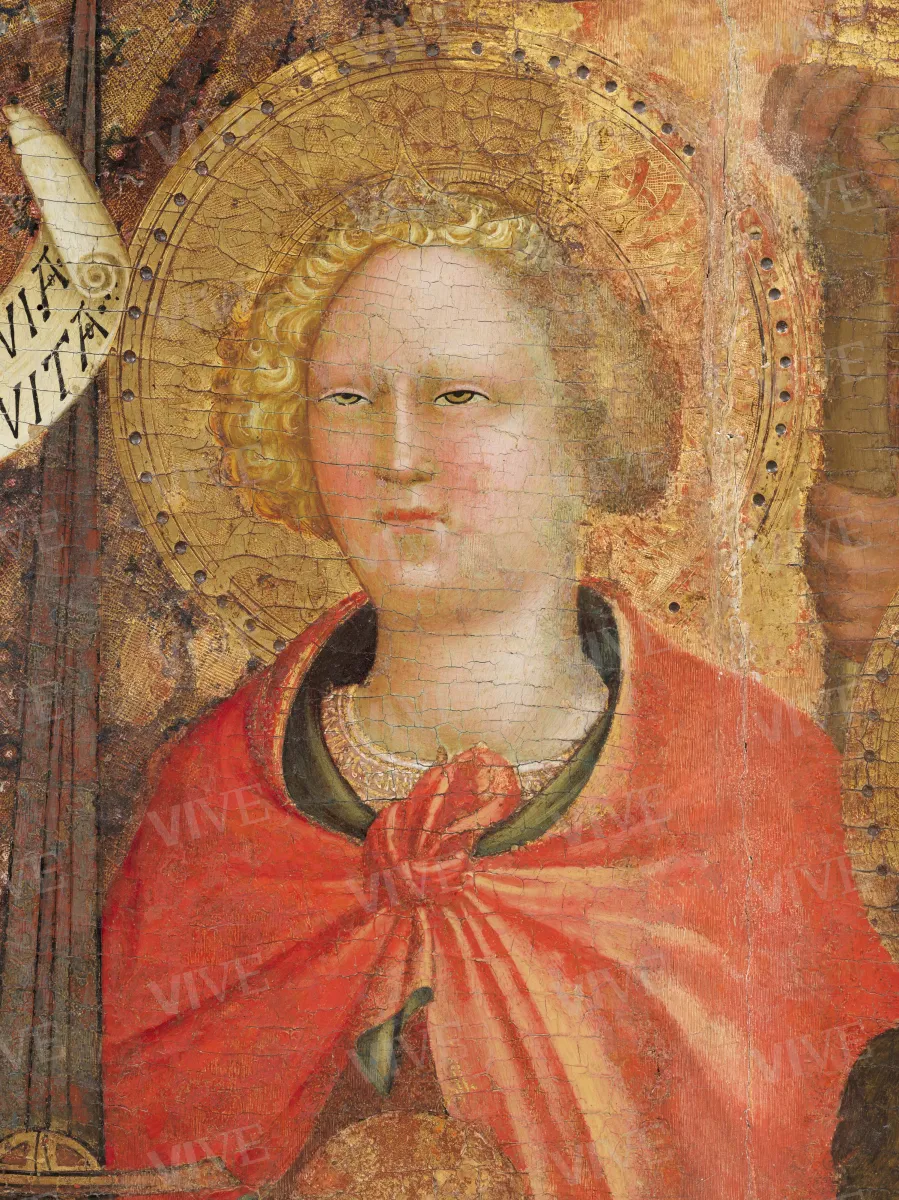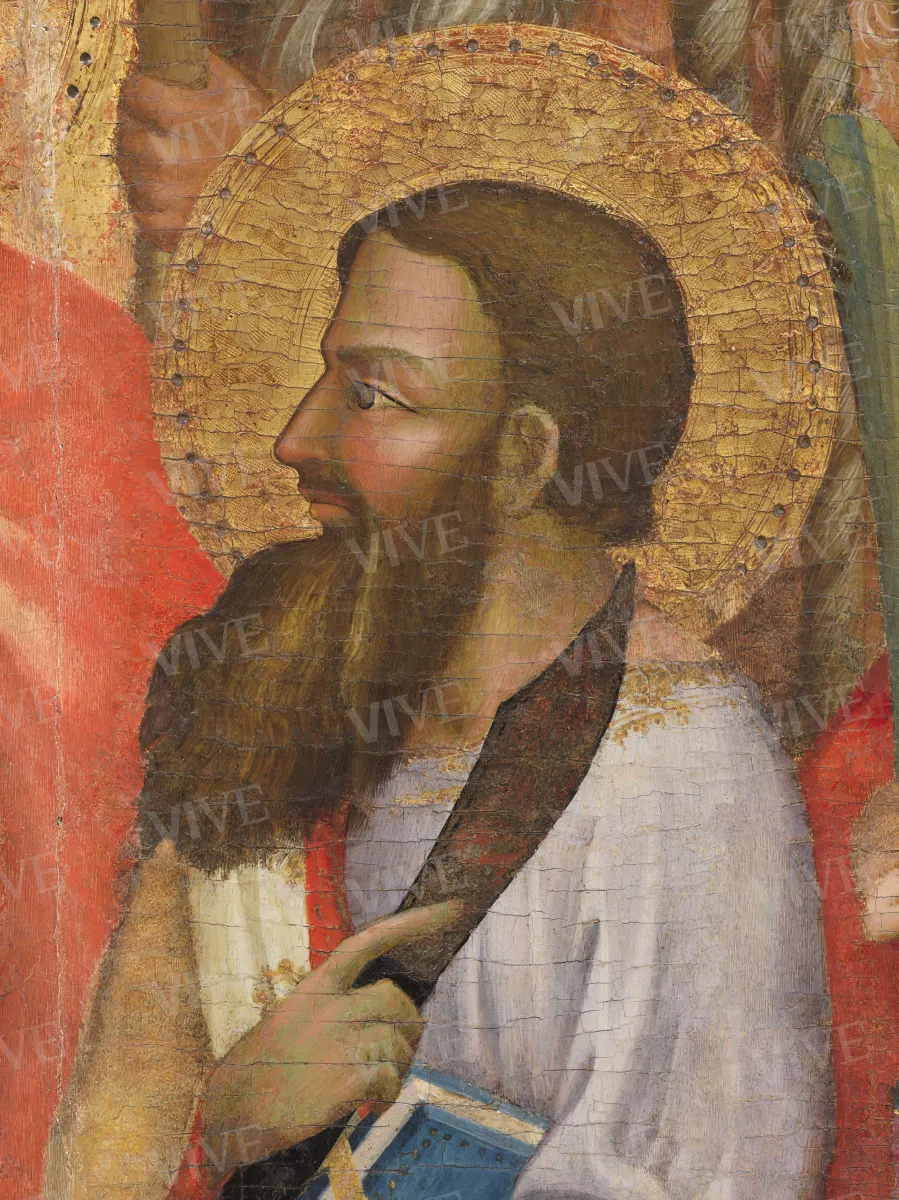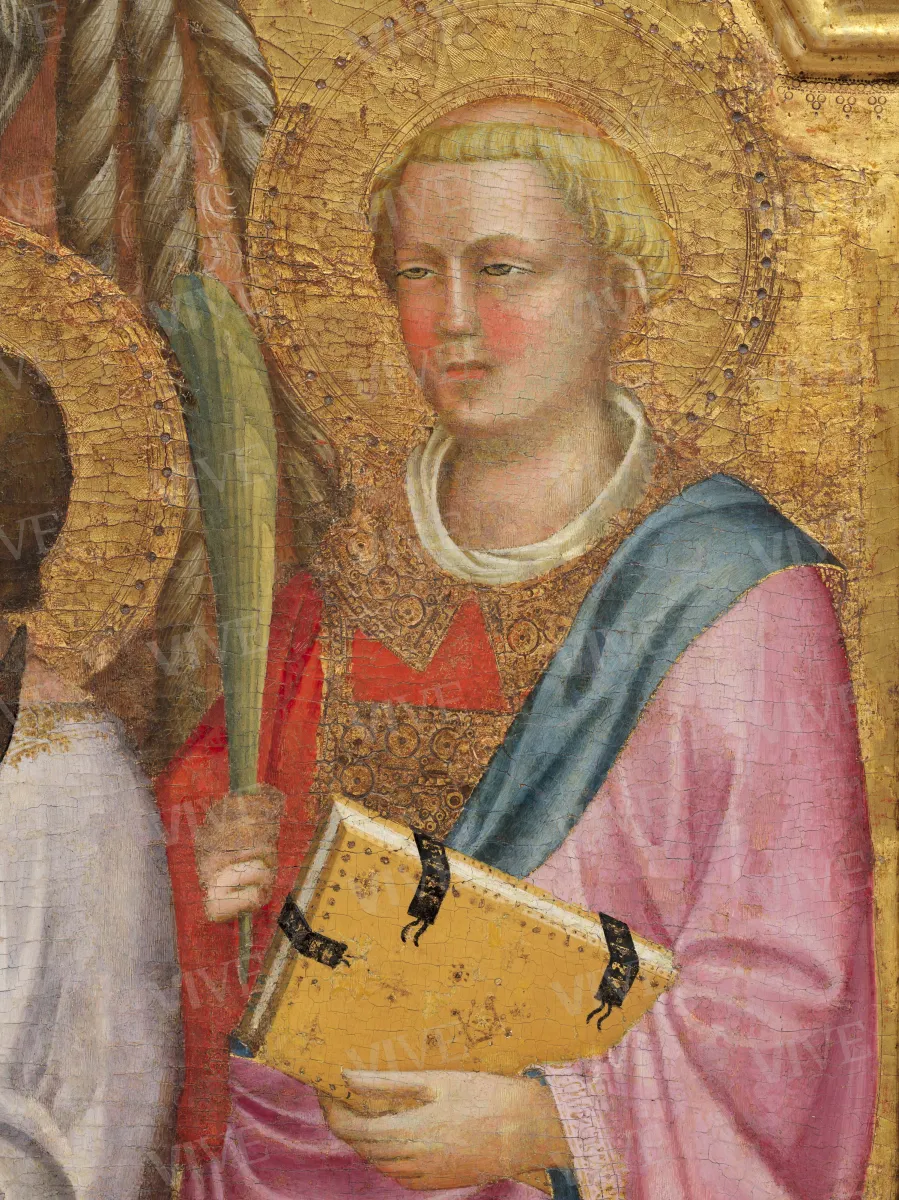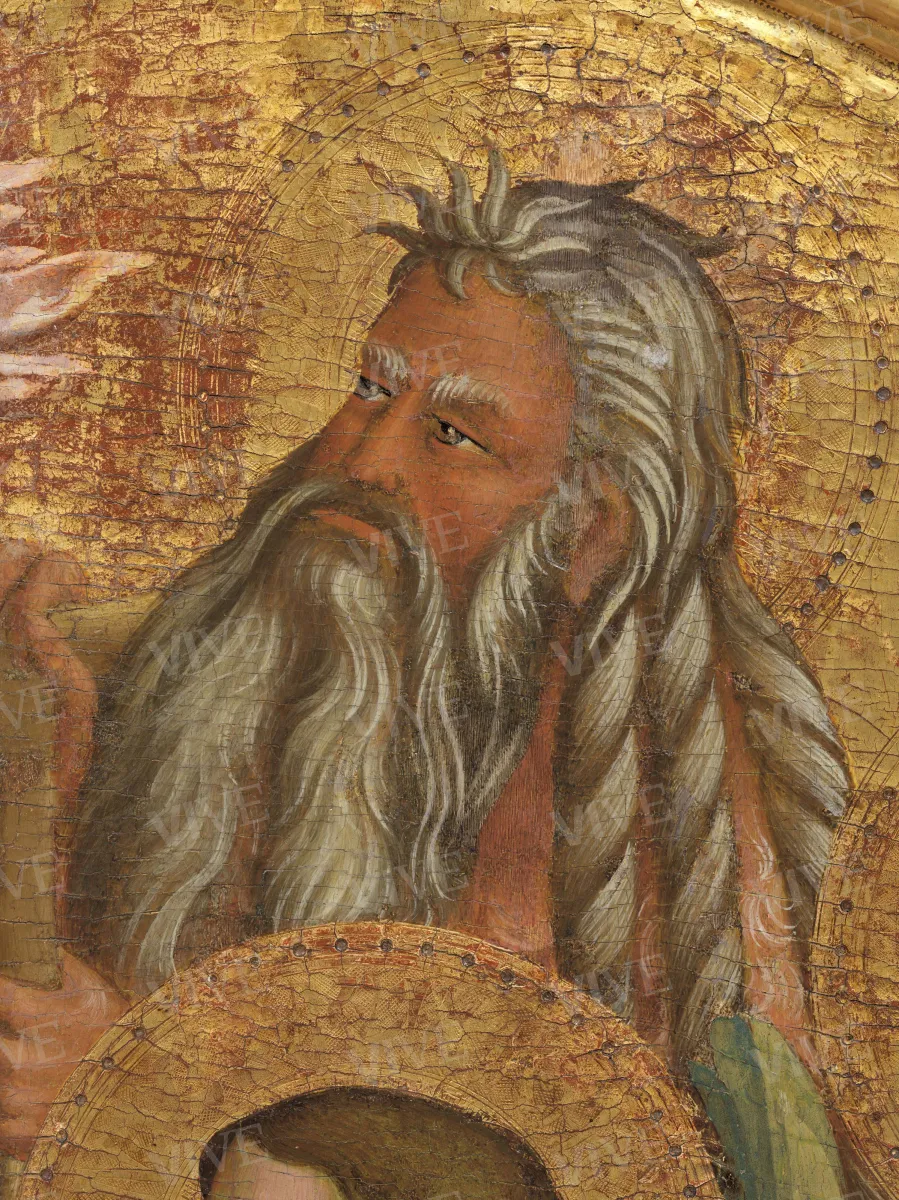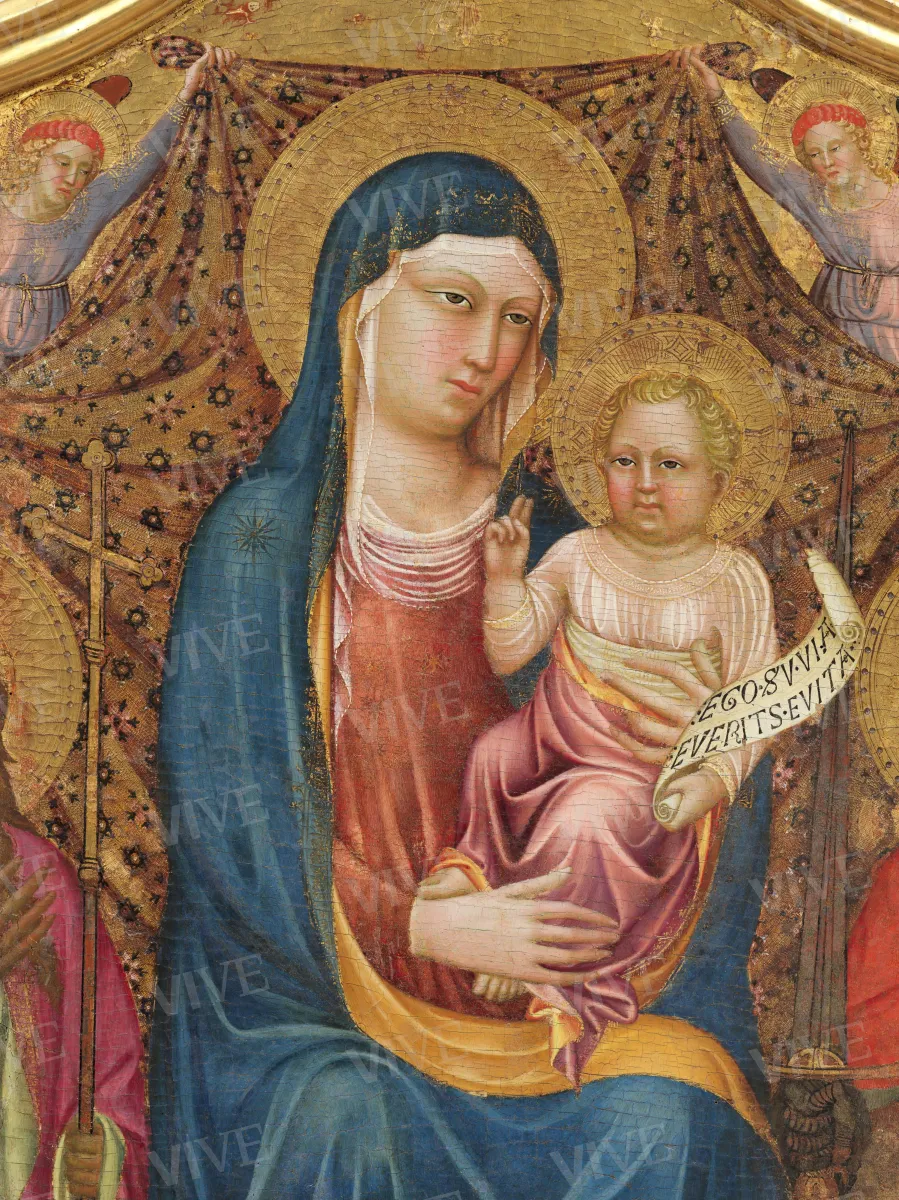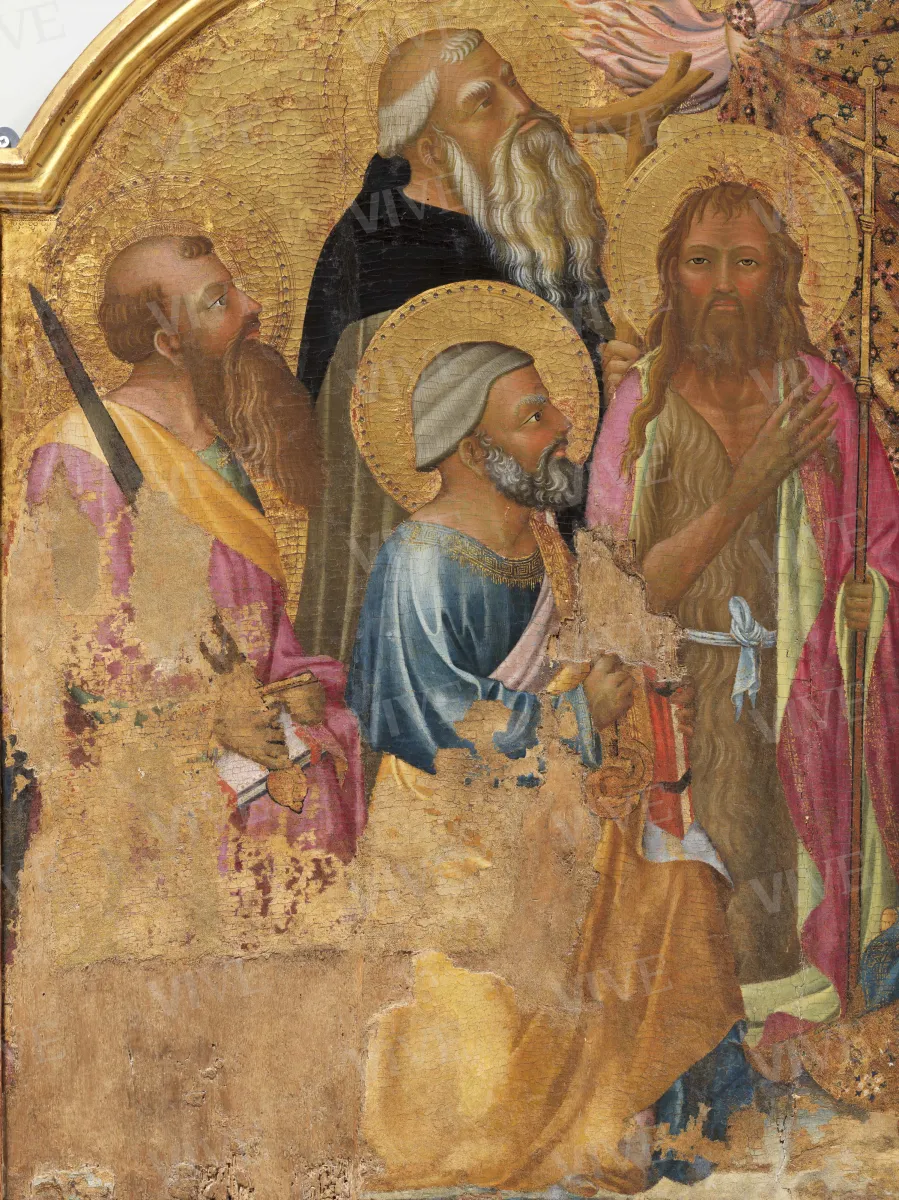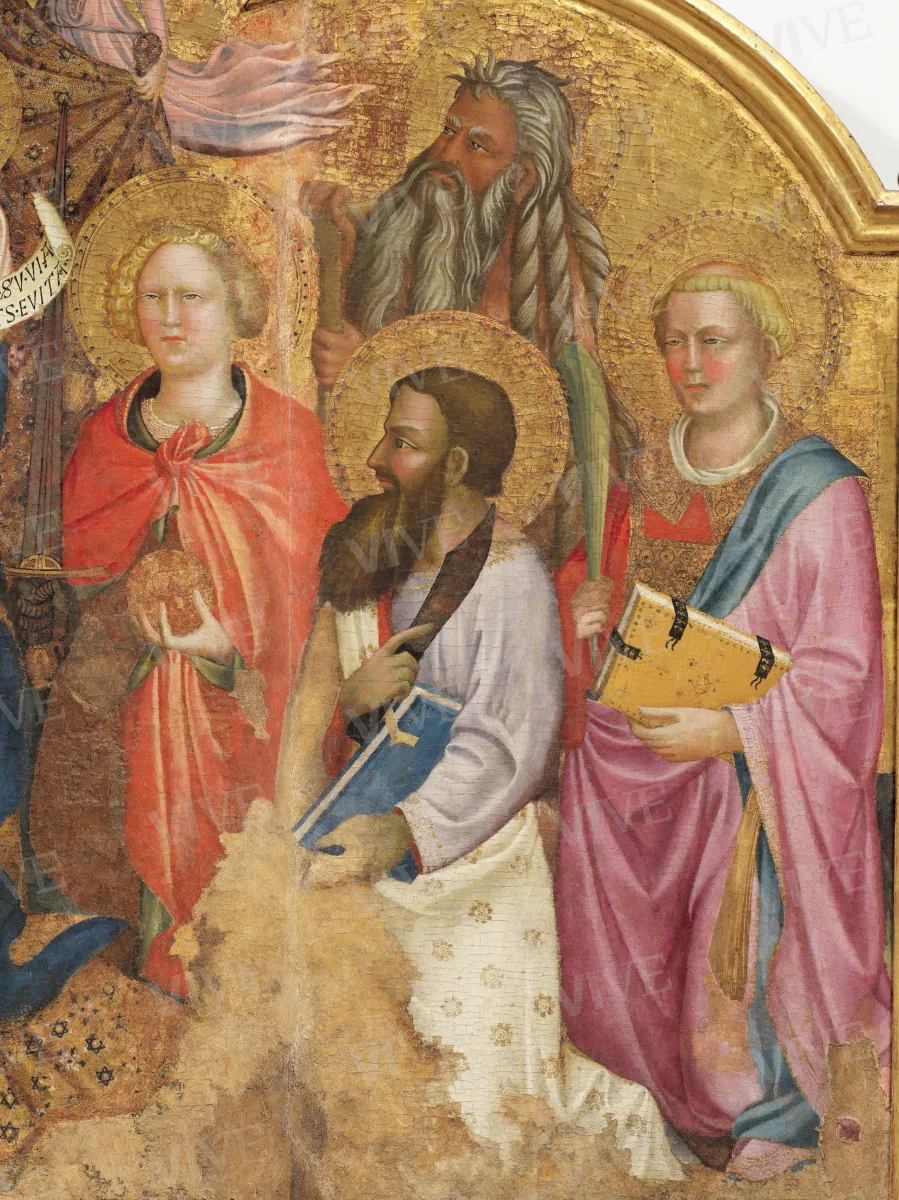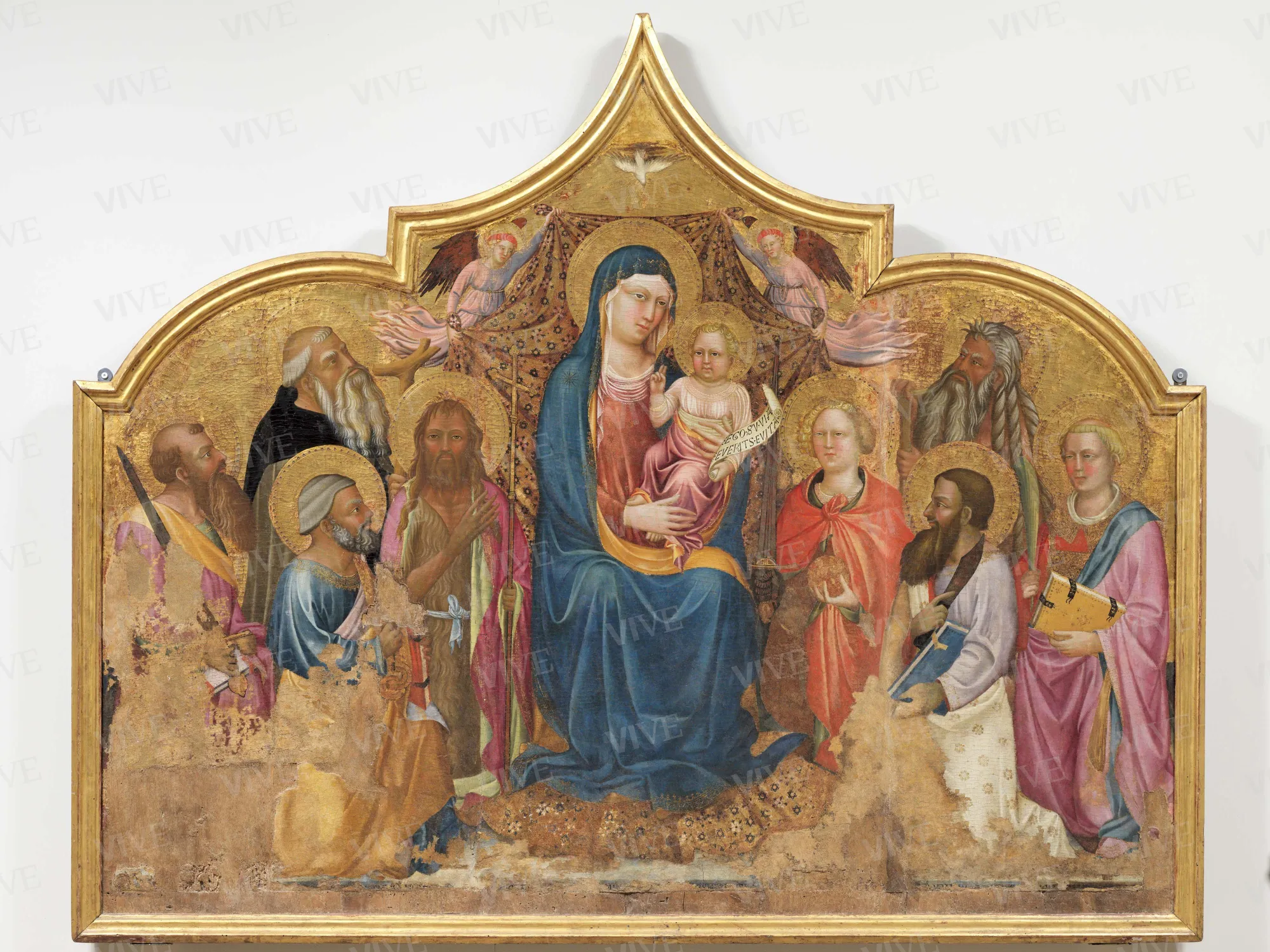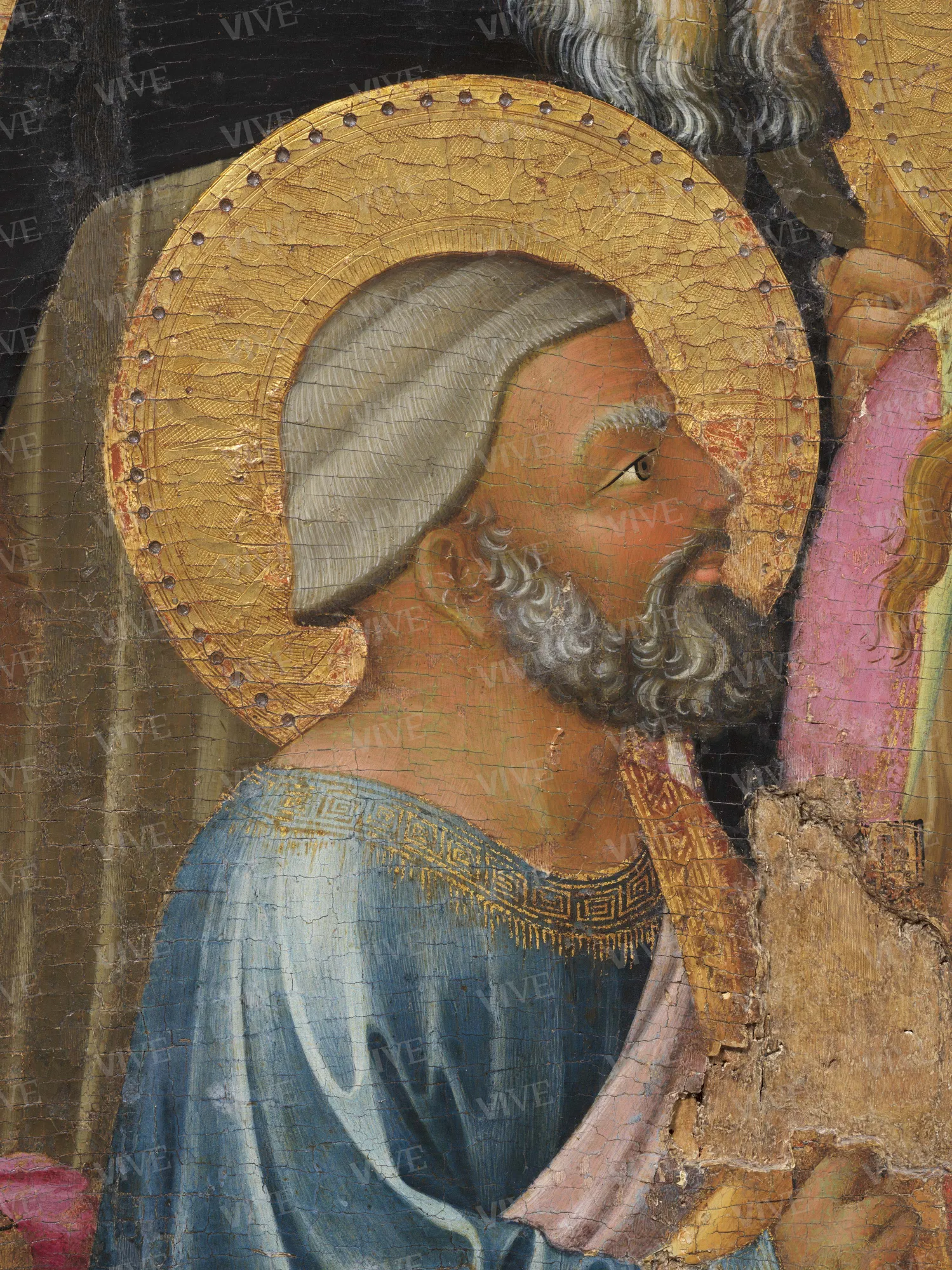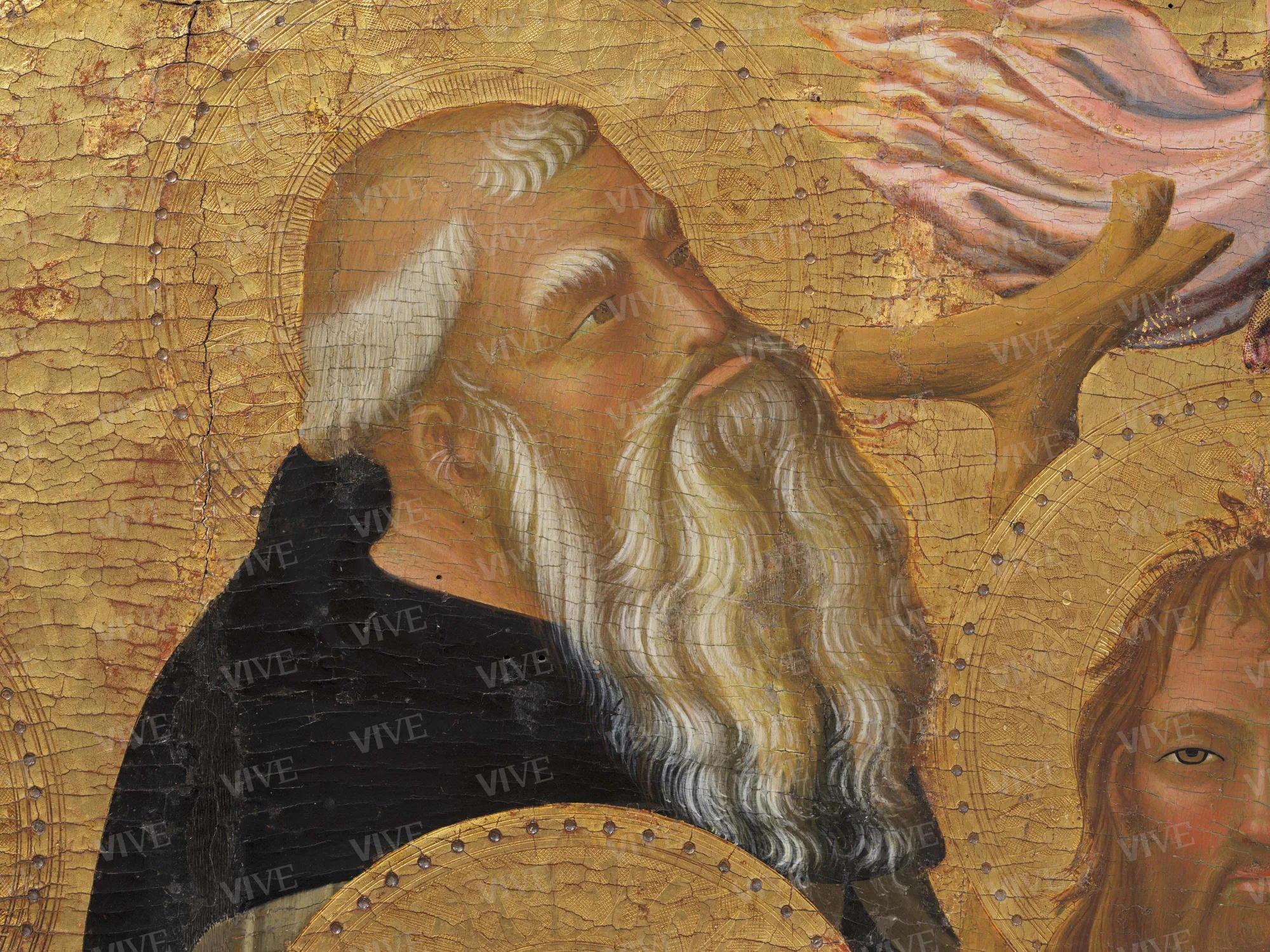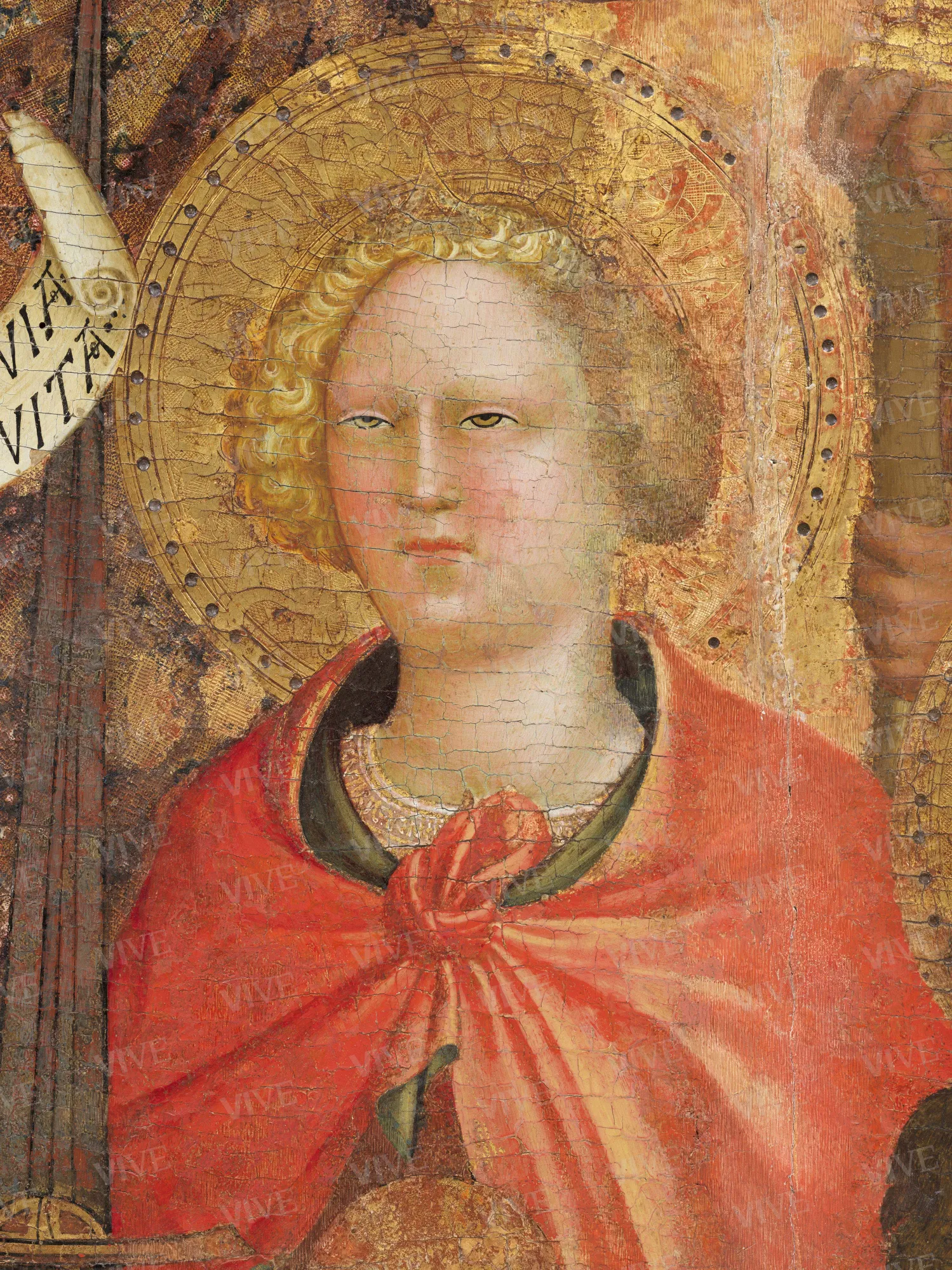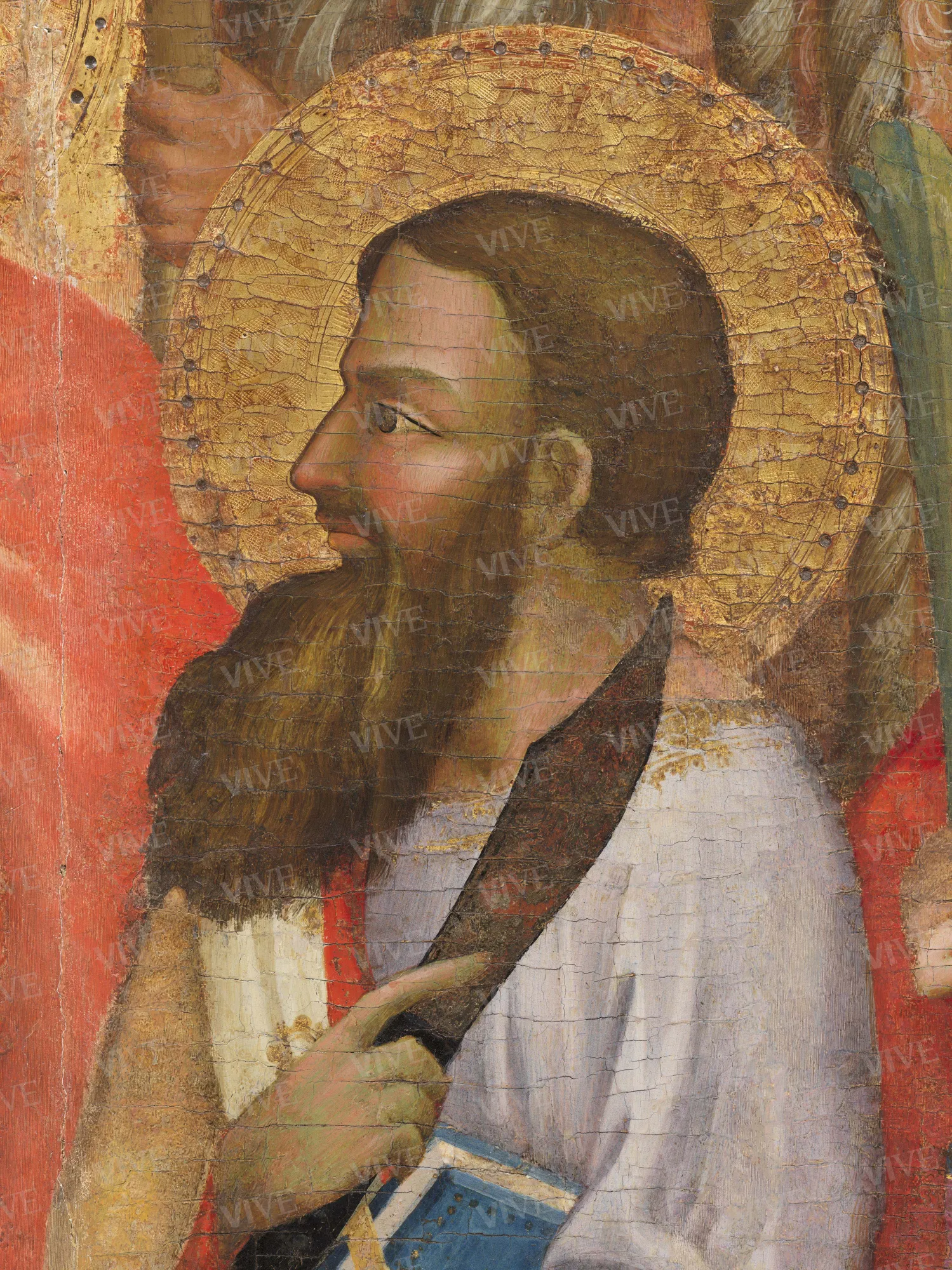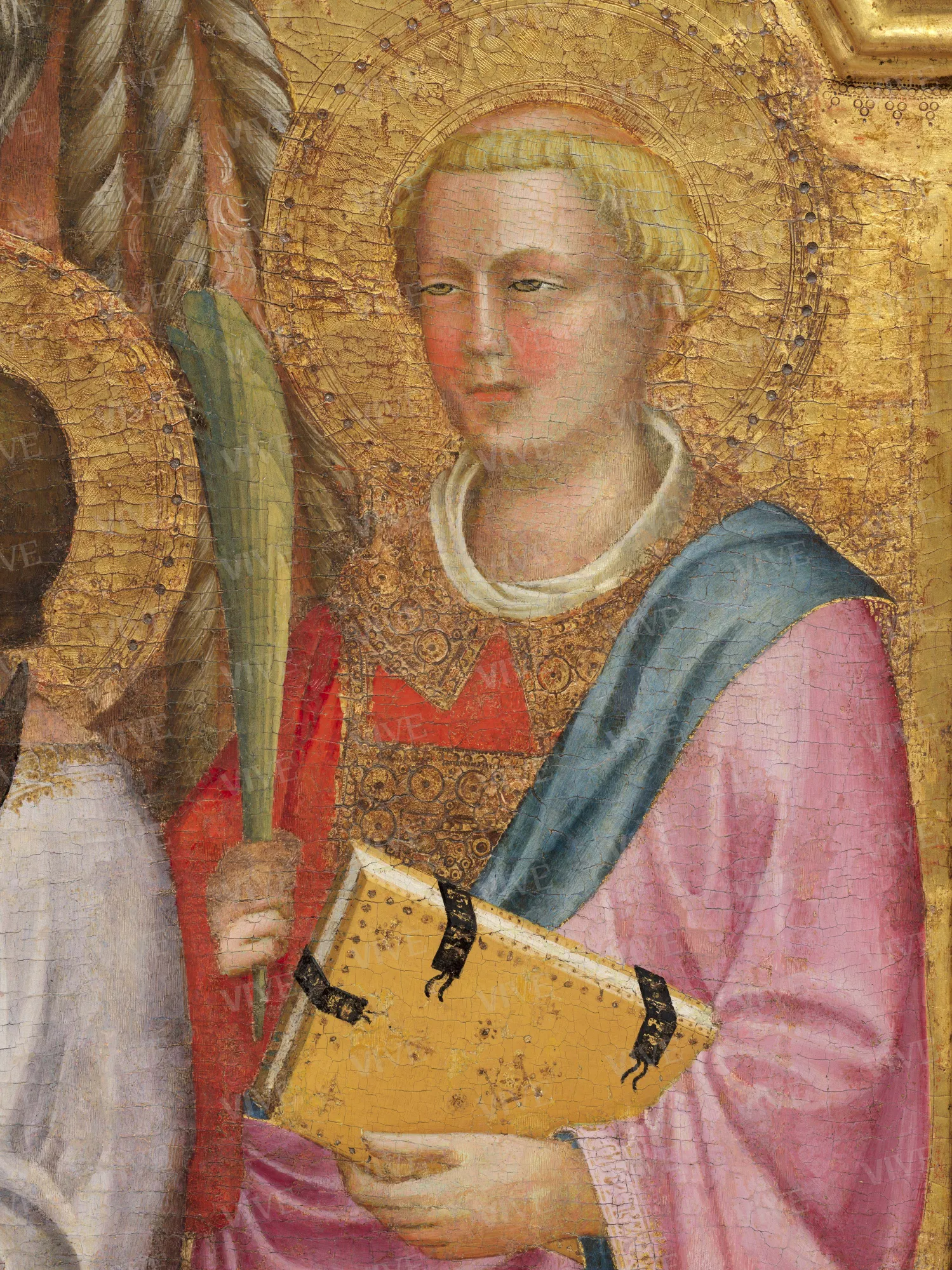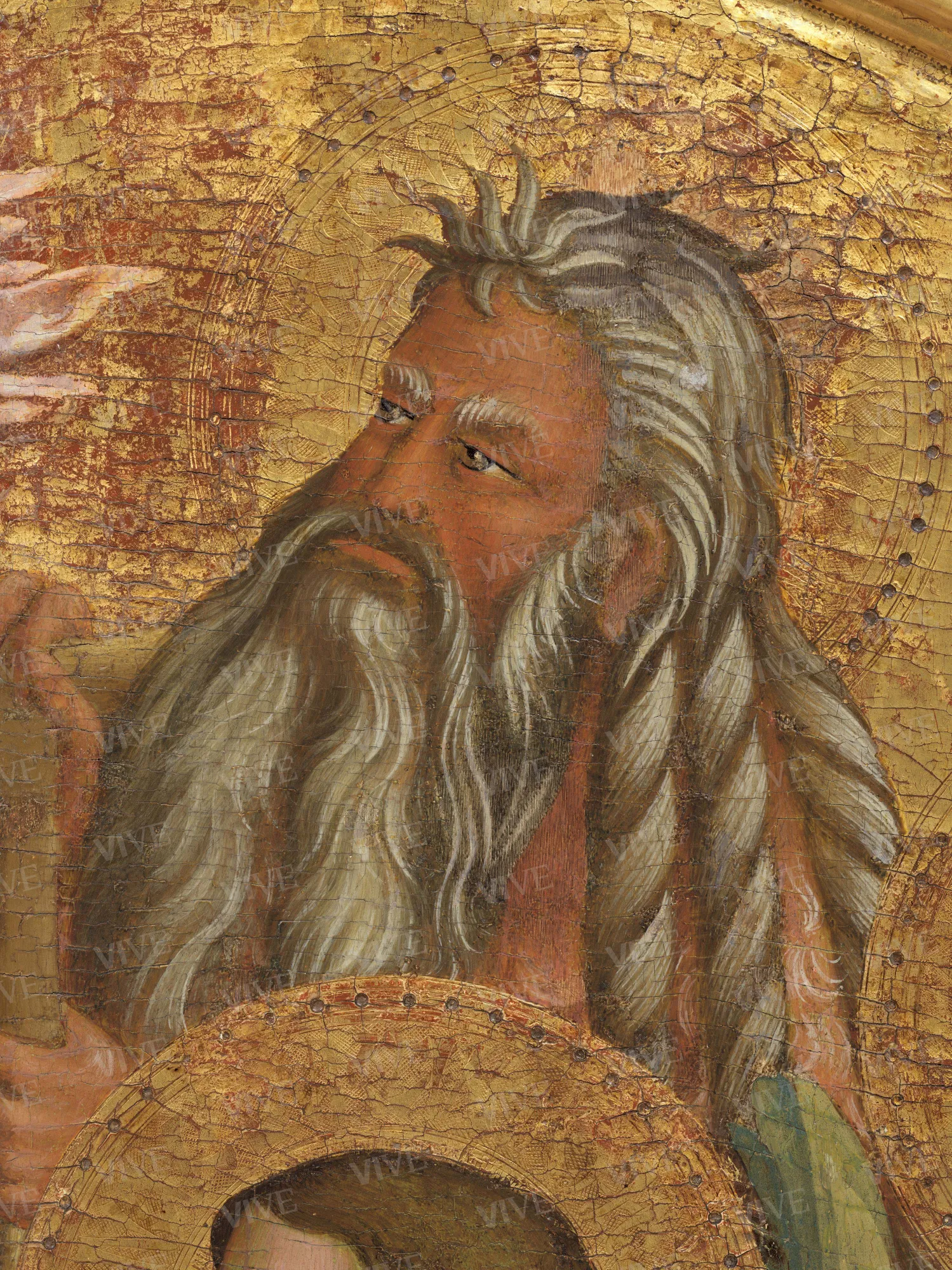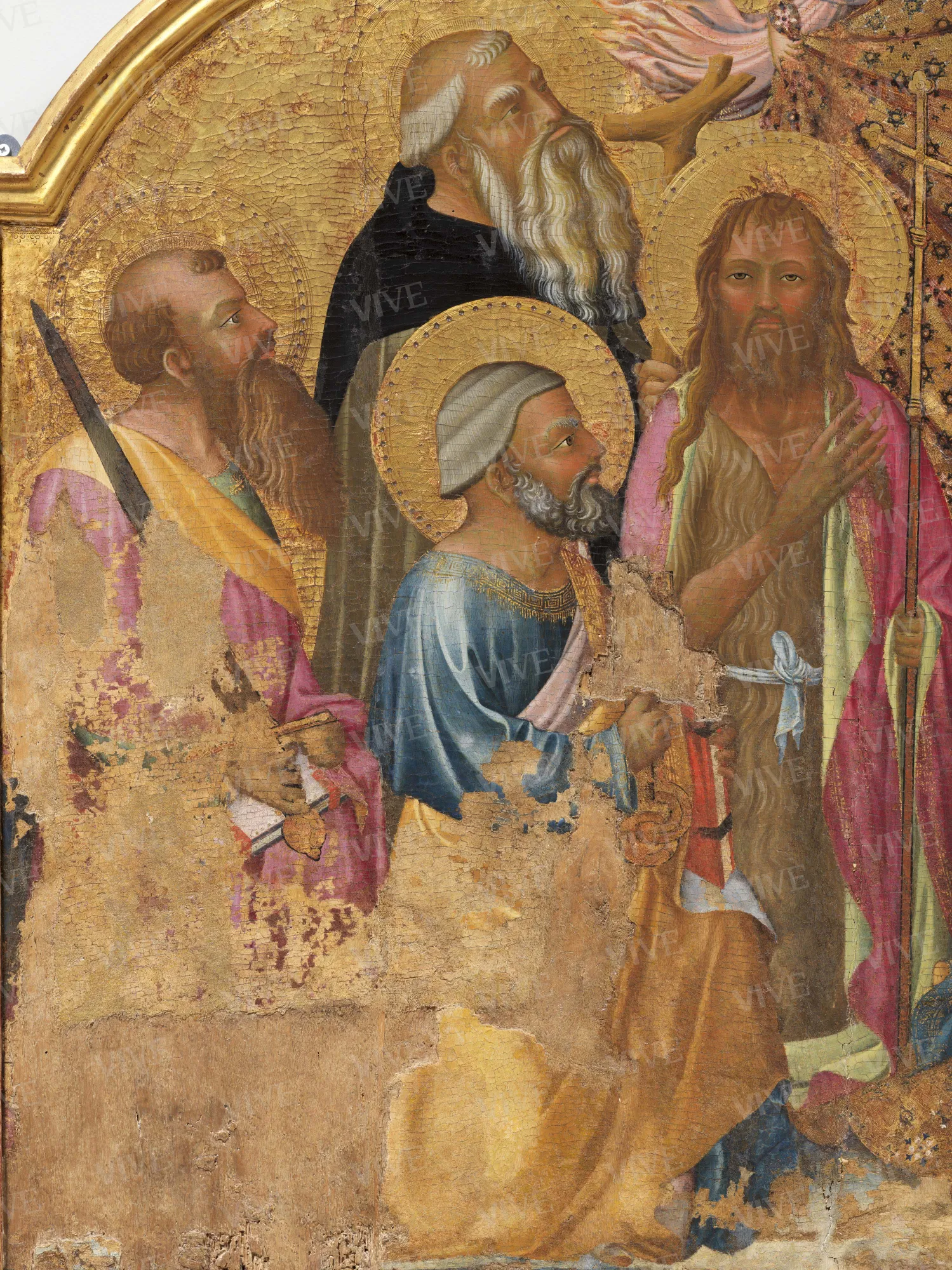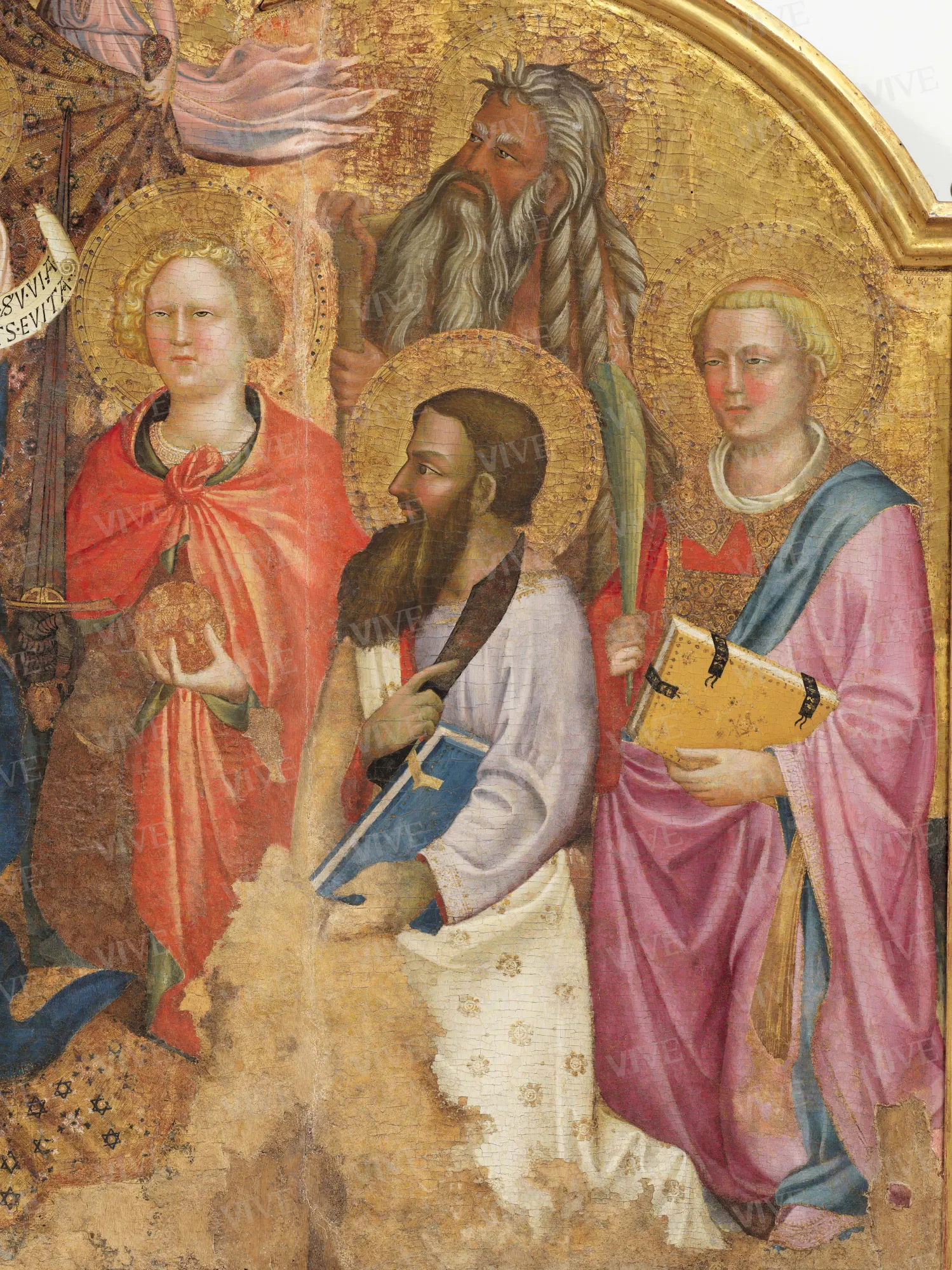Madonna and Child Enthroned between Two Angels and Saints John the Baptist, Peter, Paul, Anthony the Abbot, Michael the Archangel, Bartholomew, Onuphrius, and Lawrence
Mariotto di Cristofano 1425-1429
The exquisite panel, adorned by a mixtilinear arch, illustrates the Virgin and Child enthroned, accompanied by angels and saints. This artwork has been attributed to the painter Mariotto di Cristofano, who was notably Masaccio’s brother-in-law. Featuring vibrant colors, an opulent background, and numerous gold details, the painting is a valuable representation of a segment of Florentine painting from the early fifteenth century. While it still retains influences from fourteenth-century traditions, it also embraces elements from the International Gothic period, particularly drawing inspiration from the works of Gentile da Fabriano.
The exquisite panel, adorned by a mixtilinear arch, illustrates the Virgin and Child enthroned, accompanied by angels and saints. This artwork has been attributed to the painter Mariotto di Cristofano, who was notably Masaccio’s brother-in-law. Featuring vibrant colors, an opulent background, and numerous gold details, the painting is a valuable representation of a segment of Florentine painting from the early fifteenth century. While it still retains influences from fourteenth-century traditions, it also embraces elements from the International Gothic period, particularly drawing inspiration from the works of Gentile da Fabriano.
Details of work
Catalog entry
The panel depicts the Virgin enthroned amid eight saints, holding the blessing Child who bears a scroll inscribed with “EGO SU[M] VIA E[T] VERIT[A]S E[T] VITA.” Two angels at the sides hold open the curtain behind the throne. Despite significant color loss, particularly in the lower section, the piece is notable for its extensive use of variously applied gilding in the background, haloes, clothing details, and the richly adorned fabric behind the Virgin and at her feet. The work also features refined, sinuous light transitions that enhance the vibrant colors of the drapery.
The painting, originally from an unknown location, comes from the Sterbini Collection where it was attributed to Paolo Schiavo. After being added to the collections of the Museo di Palazzo Venezia through the Armenise donation, it was broadly assigned to the “Florentine School” based on Roberto Longhi’s suggestion, later supported by Federico Zeri (Zeri [1946] 2021, p. 72; Santangelo 1947, p. 33; Zeri 1955, p. 10). Miklós Boskovits later identified it as the work of Mariotto di Cristofano, noting its high quality and distinct colors and considering it “one of the artist’s best works” (Boskovits 1969). Mariotto di Cristofano, recorded in 1419 in the register of painters of the Compagnia di San Luca and in the register of woodcutters in Florence as “Mariotto di Cristoforo from Castello Sancto Giovanni”, was active until at least 1454 (Milanesi 1901, p. 96, no. 115; Colnaghi 1928, p. 172; Cohn 1958; Bernacchioni 2008 p. 582–585; Rossi 2012). He is known above all for marrying Masaccio’s half-sister Caterina in 1421 (Procacci 1932) and it has been suggested that Masaccio may have started his career in Mariotto’s workshop (Boskovits 2002).
Despite this connection, Mariotto is considered one of the more conservative artists of his time in Florence, drawing from the style of Bicci di Lorenzo—who was still influenced by late fourteenth-century Florentine traditions(Boskovits 1969)—and Lorenzo di Bicci, with whom it is hypothesized he trained (Frosinini 1987). However, he was also responsive to the stimulating climate engendered by the international Gothic style present in Florence thanks to artists such as Starnina, Masolino, Lorenzo Monaco, and Gentile da Fabriano, who arrived in the city in 1420 (De Marchi 1992, p. 135). These were the artists he looked to to update his own style (Boaskovits 2002; Staderini 2002). This updated influence is seen in works such as the painting in Palazzo Venezia, which exhibits adherence to newer trends and can be dated to the late 1420s. The use of a single setting, topped by a mixtilinear arch rather than the traditional division into panels, allows for larger figures within the space and reflects a search for renewed compositional unity similar to that achieved by Gentile da Fabriano and Lorenzo Monaco in their Adoration of the Magi paintings in the Uffizi.
Francesca Mari
Entry published on 27 March 2025
State of conservation
Fair, but with extensive discoloration especially in the lower portion.
Restorations and analyses
1970;
1996.
Inscriptions
In the cartouche held by the Child: “EGO SU[M] VIA E[T] VERIT[A]S E[T] VITA.”.
Provenance
Rome, Collezione Giulio Sterbini;
Rome, Collezione Lupi Family, post 1911;
Rome, Collezione Giulio Armenise, 1940;
Rome, Museo Nazionale di Palazzo Venezia, from 1940.
References
Milanesi Gaetano, Nuovi documenti per la storia dell’arte toscana dal XII al XV secolo, Firenze 1901;
Colnaghi Dominic Ellis, A Dictionary of Florentine Painters from 13th to 17th Centuries, London 1928;
Procacci Ugo, Appunti d’archivio: documenti e ricerche sopra Masaccio e la sua famiglia, in «Rivista d’arte», 14, 1932, pp. 489-504;
Santangelo Antonino (a cura di), Museo di Palazzo Venezia. 1. Dipinti, Roma 1947, p. 33;
Zeri Federico (a cura di), Catalogo del Gabinetto Fotografico Nazionale. 3. I dipinti del Museo di Palazzo Venezia in Roma, Roma 1955, p. 10;
Cohn Werner, Maestri sconosciuti del Quattrocento fiorentino, in «Bollettino d’arte», 43, 1958, pp. 64-66;
Boskovits Miklós, Mariotto di Cristofano: un contributo all’ambiente culturale di Masaccio il giovane, in «Arte illustrata», 13/14, 1969, pp. 4-13;
Fremantle Richard, Florentine Gothic Painters. From Giotto to Masaccio. A Guide of Painting in and near Florence 1300 to 1450, London 1975, p. 557, n. 1164;
s.a., Mariotto di Cristofano, in Dizionario enciclopedico Bolaffi dei pittori e degli incisori italiani, VII, Torino 1975, pp. 215-216;
Frosinini Cecilia, Alcune precisazioni su Mariotto di Cristofano, Firenze 1987;
Andreatta Emanuela, Mariotto di Cristofano, in Berti Luciano, Paolucci Antonio (a cura di), L’età di Masaccio. Il primo Quattrocento a Firenze, catalogo della mostra (Firenze, Palazzo Vecchio, 7 giugno-16 settembre 1990), Milano, 1990 p. 259;
De Marchi Andrea, Gentile da Fabriano. Un viaggio nella pittura italiana alla fine del gotico, Milano 1992;
Boskovits Miklós, Appunti sugli inizi di Masaccio e sulla pittura fiorentina del suo tempo, in Bellosi Luciano (a cura di), Masaccio e le origini del Rinascimento, catalogo della mostra (San Giovanni in Valdarno, Casa Masaccio, 20 settembre-21 dicembre 2002), Ginevra-Milano 2002, pp. 53-75;
Staderini Andrea, Pittori fiorentini dal Tardogotico al Rinascimento, in Fornasari Liletta, Gentilini Giancarlo, Giannotti Alessandra (a cura di), Arte in terra d’Arezzo. Il Quattrocento, Firenze 2002, pp. 49-76;
Bernacchioni Annamaria, Mariotto di Cristofano, ad vocem, in Dizionario Biografico degli Italiani, Catanzaro 2008, p. 583;
Rossi Sergio, I pittori fiorentini del Quattrocento e le loro botteghe. Da Lorenzo Monaco a Paolo Uccello, Todi 2012, pp. 124-125;
Zeri Federico, Federico Zeri a Roberto Longhi [7 agosto 1946], in Natale Mauro (a cura di), Federico Zeri-Roberto Longhi. Lettere (1946-1965), Cinisello Balsamo 2021, p. 72.

